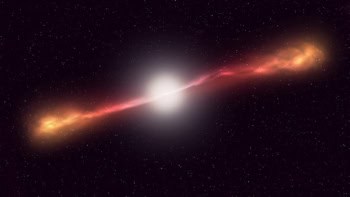
The short gamma-ray burst (GRB) that followed gravitational waves from the GW170817 neutron star merger was created in an astrophysical jet pointing 30° away from Earth, according to computer simulations by astrophysicists in the US and Italy.
Carried out by Davide Lazzati of Oregon State University and colleagues in the US and Italy, the simulations of the merger also offer an explanation for why the short GRB was much weaker than expected.
Typically lasting for less than 2 s, short GRBs and their origins have puzzled astronomers for decades. An important clue came in 2005 when X-rays and visible light were detected from the sources of two short bursts. This provided evidence that a short GRB can be created by the merger of two neutron stars to form a black hole.
The idea is that the merger creates two astrophysical jets of fast-moving material that flow out in opposite directions from the poles of the rapidly spinning black hole. Violent interactions that occur within the jet just after the merger create a short GRB. As the jet moves outward and slows down, a radiation afterglow at longer wavelengths is emitted.

GW170817 kilonova: what happened next
This model was backed up by the GW170817 event, in which a short GRB was observed at the same time as the gravitational waves from two merging neutron stars.
However, the GW170817 observations did not fit exactly with what astrophysicists expected from a neutron-star merger. For one thing, the short GRB was much fainter than predicted by theory. Furthermore, the afterglow observed in the days and weeks after the short GRB increased in brightness over time – which was not expected.
Increasing visibility
Now, Lazzati and colleagues have done computer simulations of how radiation is emitted from such a jet and concluded that we are viewing the object 30° away from the direction of the jet. Most of the luminosity of the short GRB is expected to be in a relatively tight beam along the jet, which is why it appeared weak on Earth. Conversely, as the jet blasted out into space it spread out, which means that more of it is visible on Earth. This, say the researchers, is why the afterglow brightened over time.
Writing in Physical Review Letters, the team also estimate that about 5% of short GRBs that are detected in coincidence with gravitational waves will involve jets that point directly at Earth.



